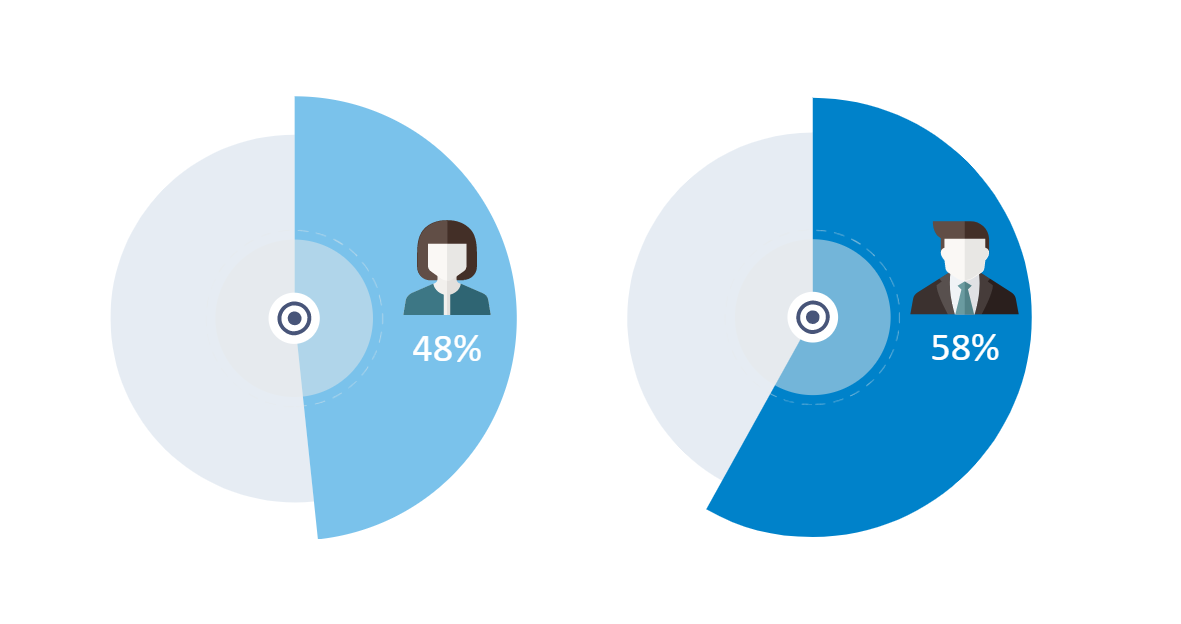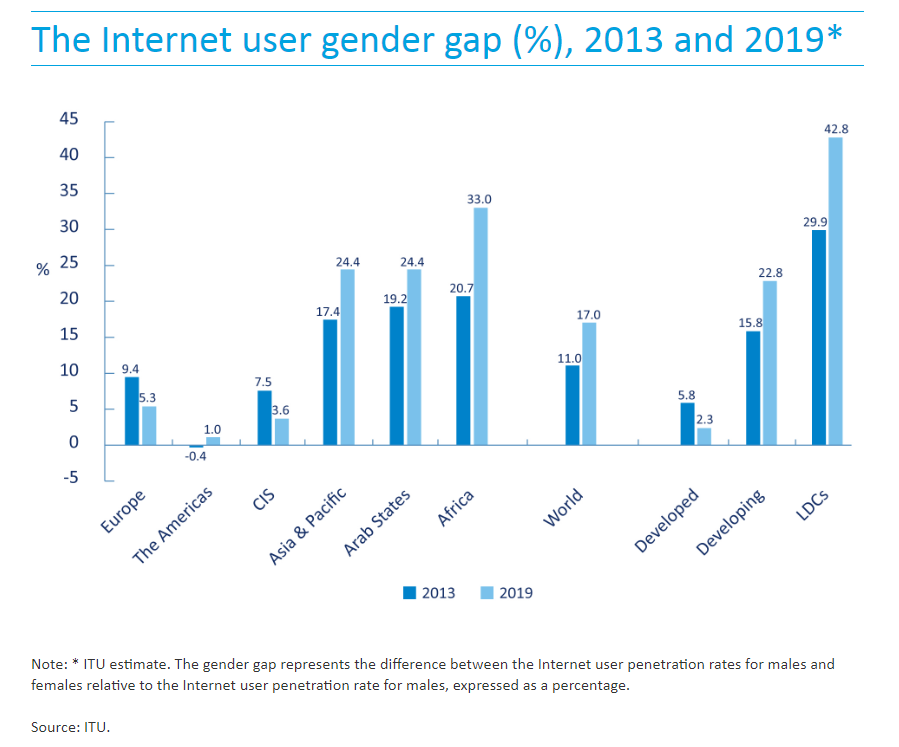Gender rights online
Historically, girls and women have faced discrimination and major inequalities in education, health, social welfare, political participation, and justice. Many of these disparities between men and women have been perpetuated online.
Women’s rights online address the online aspects of traditional women’s rights, including the right to hold office, the right to equal pay, and the right to education. With online participation, women’s involvement in public and political life has been on the rise. However, for women to take full advantage of the benefits of the internet and communication technologies, barriers such as inequality of access and technology-related violence against women must be eliminated. Violence, migration, conflict, and crisis have also affected the well-being of women and their ability to fulfil their potential both offline and online.
The digital gender gap
According to data by the International Telecommunications Union (ITU), the proportion of women using the Internet globally is 48%, compared to 58% of men. In relative terms, the global Internet user gender gap is 17%. 

Online violence against women
Among the acts of violence perpetrated against women online are cyberstalking, surveillance and privacy breaches, sexual harassment, and the unauthorised use and manipulation of personal information, including images and videos. The 2016 Report of the UN Special Rapporteur on violence against women, its causes and consequences noted online violence against women as a new challenge. The report stated that ‘while the use of information and communications technology has contributed to the empowerment of women and girls, its use has also generated online violence’. It called on stakeholders to ‘fight online violence against women and girls while respecting freedom of expression and the prohibition of incitement to violence and hatred’ (UN, 2016). The 2018 Report of the UN Special Rapporteur on violence against women, its causes and consequences noted that there are many emerging forms of online violence against women and girls (such as doxing, sextortion, and trolling). However, there are also some forms of violence against women that are not completely new but have developed digital connotations (such as online mobbing, online stalking, and online harassment). Technology has transformed different forms of gender-based violence into something that can be perpetrated across distance, without physical contact, and beyond borders The use of anonymous profiles can amplify the harm to the victim. The report underlined the urgent need to fully apply human rights standards to all forms of online violence against women and girls and to develop specialised legislative measures at the national level. In 2018 the UN Human Rights Council (UNHRC) adopted the resolution ‘Accelerating efforts to eliminate violence against women and girls: preventing and responding to violence against women and girls in digital contexts’. The resolution enumerates harassment, stalking, bullying, threats of sexual and gender-based violence, death threats, arbitrary or unlawful surveillance and tracking, trafficking in persons, extortion, censorship, and the hacking of digital accounts, mobile telephones and other electronic devices as forms of violation, abuse, discrimination, and violence women face in digital contexts. The resolution also calls on businesses to implement the Guiding Principles on Business and Human Rights, protect the private data of women and girls, create transparent and effective processes for reporting violence, and develop policies that meaningfully protect women and girls from violence in digital contexts. In the era of ubiquitous connectivity, creating safer online spaces with the co-operation of Internet intermediaries comes into sharper focus as a first step towards the full realisation of women’s human rights and development.
ICT-enabled violence against women
Even women who decide to avoid going online are vulnerable to ICT-facilitated abuse, ITU pointed out in its State of Broadband 2019 Report. Women lacking digital skills may be unaware when technology is being used to control and abuse them, and are therefore unable to safeguard against ICT-facilitated violence. For instance, tracking applications commonly installed on mobile phones may be used by men to monitor women’s movements and activities, often without their knowledge. In countries where smart home devices are increasingly common, domestic violence responders have noted an uptick in the number of women reporting abuse cases involving Internet-connected locks, thermostats, cameras, and other devices. Women need digital skills to be able to safeguard against ICT-facilitated violence, recognise abuse when it is occurring, and take steps to protect themselves and access recourse and help.
Protecting women's rights online
The protection of women’s rights online is part of a broader sociocultural and professional shift focusing attention on reducing discrimination and diminishing bias in the exercise of rights, including accessing educational and economic opportunities, holding office, and receiving equal pay. The main international instruments for the protection of women’s rights are the 1952 Convention on the Political Rights of Women and the 1979 Convention on the Elimination of All Forms of Discrimination against Women. Both UN Women and the UNHRC work actively on various dimensions of women’s rights. Groups such as the Association for Progressive Communications (APC) and the Internet Governance Forum Dynamic Coalition on Gender and Internet Governance have been actively involved in advocacy for women’s rights online. Support for women’s rights online is also offered by the World Wide Web Foundation’s Women’s Rights Online: Raising Voices. As the women’s rights movement has matured, a shift is happening to recognise that women’s rights are actually part of broader gender rights issues, which cover the rights of gender minorities. Human rights issues for women, men, and other gender minorities, such as the LGBTQ community, consist of access to information, professional opportunities, global policy processes, and other rights critical for human rights and internet governance and that must be studied and addressed accordingly.
